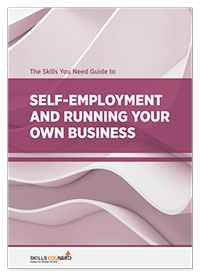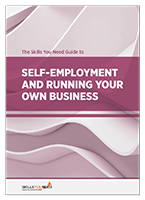Top Tips on Freelancing
See also: Work-Life BalanceFreelancing is defined as being self-employed and working for different companies or individuals on particular projects.
Freelancing is increasingly the employment model of choice in creative industries, including information technology, writing, design and editing. Freelancing gives you the freedom to determine your own working patterns and time, but it also brings its own challenges.
From winning work to managing clients, these challenges may well be new to you if you have not previously worked for yourself. This page brings together top tips to help you become a more successful freelancer, whether you are new to freelancing or more experienced.
1. Identify areas where you can specialise
You may believe that you can write on any topic, or that your design expertise is equal to any challenge, but your potential customers want an expert. If you are bidding for work via a freelance website or similar platform, your potential customers will receive a lot of bids, especially if the job is attractive. You need to stand out from the crowd, so identify areas where you can specialise, and where your personal experience will add value for your clients.
Develop a suitable portfolio around that area, so that you can showcase your skills to potential clients and demonstrate your expertise. It is, however, a bad idea to do work on spec, that is, without it having been commissioned, as you may never sell it.
Specialising and tailoring
You may decide to specialise in two or three areas. If so, make sure that you have a dedicated portfolio for each one, and tailor your bid to match the requirements.
2. Spread your net wide to find clients
You may already have plenty of contacts in your freelance area, because you have been working in that business for some time. If so, projects may come easily. If not, you will need to put in some work to find potential clients, and it is worth spreading your net wide, at least when you start. For example, you might:
Set up your own website or blog to showcase your expertise (and if so, remember to do some work to ensure that you know and understand search engine optimisation);
-
Set up or update your LinkedIn profile to reflect the work that you are seeking;
Use freelancing websites , which allow you to bid for jobs, and will often provide services such as holding deposits, which may help you to feel safer doing the work;
Approach potential clients directly with a pitch; and
Look for companies who use large numbers of freelancers in your chosen field, and get in to their freelance pool.
All these will give you options to find clients. As you identify which routes are more successful, you can focus on those and move away from the others.
3. Set your price—and stick to it
Your hourly rate needs to be enough to meet your needs. It is no good if you cannot earn enough in your chosen freelance field to pay your bills.
Start, therefore, by identifying the rate that you need or want to earn. You can then use freelance websites to see if you can earn that rate in your field, or whether you are prepared to accept the rate that you can earn.
Once you have decided on your hourly rate, stick to it as much as possible.
Remember that when you start, you may need to reduce your ideal price until you have built up your reputation, but you still need to be thinking about what you want to earn in the longer term, and what you need to earn in the meantime.
DO NOT bid for work that is radically below your ideal rate.
You want to get a reputation for quality delivered on time, not shoddy, cheap work. A little below your ideal rate is fine until you have built your reputation. A lot below is not. As you build up your client list, you will become able to afford to turn down work that offers less than your ideal hourly rate.
Providing samples: a difficult question
As a principle, you should never work for free.
It follows, therefore, that you should not do ‘just one article’ or ‘a rough design’ as a sample or test for a possible client. Think about it this way: if they ask ten freelancers to each write a sample article, that is ten free blog posts.
Good clients do not ask for samples: they look at your portfolio and decide. If they are not sure, they agree that you should do a small piece of work first, for an agreed price, and then extend the contract if they like it.
When you first start out, and you do not have client references, it may be harder to say no when asked for samples. You may just have to take a hit from time to time if you want the work. It is worth trying to resist, however.
4. Set expectations clearly for EVERY job, and keep communicating
You may or may not want to have a formal contract for every job or project that you undertake. It is, however, a good idea to set out clearly and simply what you expect to do, what you can deliver and by when, and how you will work, including your working hours, invoicing and payment terms. If there is any question of copyright, you should also make this clear.
Exactly what you need to set out will differ by freelancing field but, broadly speaking, this is about setting expectations: yours and your client’s.
The general principle should be NO SURPRISES. Your client should know what to expect, by when, the process you will use, and how and when you expect to be paid. You should always be careful NOT to over-promise: be sure that you can meet any deadlines that you agree.
TOP TIP!
Before you start any work, make sure that you have your client’s agreement to go ahead. If you do not use a formal contract, at least have an email saying that they agree to your terms, and to please start work.
Useful phrases for you to use to trigger this include:
“If you agree, please confirm by email, and I will start work.”
“Please let me know that you accept these terms, and I can then start your project.”
It is also a good idea to communicate regularly during the project, especially if it is a long one. Weekly progress updates will go a long way to reassuring an anxious client that you are on track.
5. Be prepared to turn down work
When you first start freelancing, the idea of turning down work may seem anathema. It is, however, better to turn down work than fail to deliver it, or deliver something that is not to the required standard.
You should always turn down work if:
You are not confident of meeting the required deadline, although it is worth trying to negotiate the deadline, or seeing if you can move other work around to do the more urgent work first.
You do not think you can do it, for example, because you do not know enough about the subject matter, or it is outside your main area of expertise. It is better to get a reputation for being honest, and only being prepared to take on work that you can do well, than one for doing shoddy work.
The price is too low, and you will not meet your desired hourly rate. Again, it is worth trying to negotiate this, because once a client has identified you as suitable, they may not want to bother looking around further.
You do not feel comfortable with the work. You might, for example, be concerned that you are being asked to do something unethical, such as write an academic essay for submission under your client’s name. You might just feel that the client is being too demanding (asking for sample work to be done upfront, or expecting you to respond rapidly to emails over a weekend). You are fully within your rights to say that you do not have time or capacity to do the work, and not feel guilty. Some jobs are not worth the grief.
Further Reading from Skills You Need
The Skills You Need Guide to Self-Employment and
Running Your Own Business
If you are thinking about running your own business, or already do so, but feel that you need some guidance, then this eBook is for you. It takes you through self-employment in easy steps, helping you to ensure that your business has more chance of success.
The Skills You Need Guide to Self-Employment and Running Your Own Business is the guide no new or aspiring entrepreneur can afford to be without!
Based on our popular self-employment and entrepreneurship content.
And finally…
Success in freelancing will not come overnight, and you will not win every project.
Over time, however, you should win more work and, more importantly, start to get repeat business and word-of-mouth recommendations. These tips will help you to become more successful in doing so, and in managing your business and your clients on the way.


